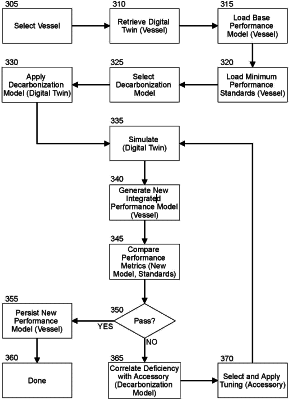| CPC G01M 15/102 (2013.01) [G05D 1/0094 (2013.01)] | 16 Claims |

|
1. A method for generating and tuning an integrated vessel performance control model to meet decarbonization goals comprising:
loading from persistent storage into memory of a computing platform, an base performance model for a vessel, the base model observed performance metrics of the vessel corresponding to a specified set of control inputs for the vessel, and corresponding observed carbon emissions from the vessel responsive to the specified set of control inputs for the vessel;
selecting a decarbonization model in the persistent storage, the decarbonization model correlating deployment into the vessel of a set of one or more accessories and a reduction in the carbon emissions resulting from use of the set of one or more accessories;
computing a new integrated performance model for the vessel modeling new performance metrics resulting from the deployment of the one or more accessories and comparing the new performance metrics to a minimum standard of performance metrics for the vessel; and,
on condition that one of the new performance metrics fails to meet the minimum standard of performance metrics, identifying a corresponding one of the accessories in the set impacting the one of the new performance metrics, incrementally applying an adjustment to the identified corresponding one of the accessories until the one of the new performance metrics is determined, to meet the minimum standard of performance metrics, simulating the new performance model in order to predict resulting carbon emissions and storing the resulting carbon emissions in the new performance model.
|